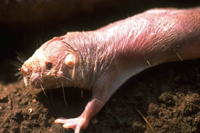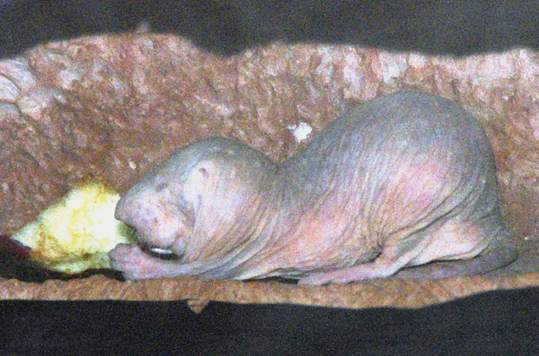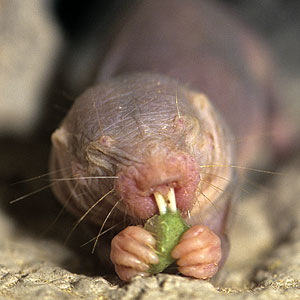 Eusociality in Naked Mole-Rats
Eusociality in Naked Mole-Rats
Biology 342 - Fall 2010
Isabel Cylinder & Quinn Amacher
Mechanism
What is Mechanism?
Mechanism is defined as “the structure or arrangement of parts of a machine or similar device, or of anything analogous.“ (18). In terms of animal behavior, then, mechanism refers to what a behavior is, and how it is constructed.
What is Eusociality?
 By definition, eusocial means, “of or pertaining to a form of insect society, as that of ants, characterized by specialization of tasks and cooperative care of the young” (9). That the idea of eusociality fundamentally excludes mammals (and all other non-insects) shows just how extraordinary it is that H. glaber would exhibit such a behavior. Alexander et al. say that eusociality in mammals refers to “…species that live in colonies of overlapping generations in which one or a few individuals produce all the offspring and the rest serve as functionally sterile helpers (workers, soldiers) in rearing juveniles and protecting the colony” (22, p. 3). Burda et al. argue, “…additional criteria such as the existence of castes, colony size, reproductive skew, and social cohesion are not pertinent to the definition…” (4, p. 293), though others would disagree. Regardless of whether or not such criteria need be included in the definition, however, they are certainly present in observed behavior of H. glaber, and serve to strengthen the assertion that the naked mole-rat is, in fact, a eusocial mammal.
By definition, eusocial means, “of or pertaining to a form of insect society, as that of ants, characterized by specialization of tasks and cooperative care of the young” (9). That the idea of eusociality fundamentally excludes mammals (and all other non-insects) shows just how extraordinary it is that H. glaber would exhibit such a behavior. Alexander et al. say that eusociality in mammals refers to “…species that live in colonies of overlapping generations in which one or a few individuals produce all the offspring and the rest serve as functionally sterile helpers (workers, soldiers) in rearing juveniles and protecting the colony” (22, p. 3). Burda et al. argue, “…additional criteria such as the existence of castes, colony size, reproductive skew, and social cohesion are not pertinent to the definition…” (4, p. 293), though others would disagree. Regardless of whether or not such criteria need be included in the definition, however, they are certainly present in observed behavior of H. glaber, and serve to strengthen the assertion that the naked mole-rat is, in fact, a eusocial mammal.
Pictured: A naked mole-rat with eyes open. Note the large front teeth used in tunnel excavation. (F)
Eusociality and Reproduction
 At the very heart of the eusocial structure is the breeding female (sometimes referred to as the “queen”). She is the only reproductively active female in the entire colony, and thus all colony members are either her offspring or her close relatives. She is responsible for the care and upbringing of all pups in the colony, with the help of 1 to 3 reproductive males. Reproductive females have been shown to breed for over thirteen years, producing litters of up to 27 pups every two to three months. If the breeding female is removed from the colony, other females in the colony will undergo a rapid increase in body mass in preparation for possible reproduction. In order to lay claim to reproductive status, these new large females will fight each other, often to the death, until a successor emerges (22).
At the very heart of the eusocial structure is the breeding female (sometimes referred to as the “queen”). She is the only reproductively active female in the entire colony, and thus all colony members are either her offspring or her close relatives. She is responsible for the care and upbringing of all pups in the colony, with the help of 1 to 3 reproductive males. Reproductive females have been shown to breed for over thirteen years, producing litters of up to 27 pups every two to three months. If the breeding female is removed from the colony, other females in the colony will undergo a rapid increase in body mass in preparation for possible reproduction. In order to lay claim to reproductive status, these new large females will fight each other, often to the death, until a successor emerges (22).
Most animals in the colony are non-breeding. All females save one are reproductively quiescent, with underdeveloped ovaries and uteri (14). This is not to say they are sterile; rather, they are “sociologically suppressed by aggressive dominance of the breeding female” (14, p. 3). Though about three-quarters of the male population undergo spermatogenesis, none of the colony members (save the breeding female and her 1 to 3 male counterparts) exhibit mating behavior (13,22).
Pictured: A pregnant breeding female surrounded by smaller non-breeding colony members. (14)
Social Structure and Castes
 Naked mole-rats are subterranean beings, which spend their entire life in an underground burrow system. This system is comprised mainly of deeply dug chambers (nests, toilet chambers, food storage, etc.), though there are even deeper tunnels for protection and thermoregulation, as well as more shallow tunnels for foraging purposes. These complex burrows require a good deal of maintenance – a task performed primarily by small, non-breeding individuals. Larger non-breeding individuals, on the other hand, take on more of a defensive role, patrolling the burrow and guarding the nest chamber. Males and females participate equally in each of these two roles; the only determining factor is body weight. Because mole-rats grow larger throughout their lifetime, it has been hypothesized that colony-maintenance and foraging fall to the younger generation, while the older generation graduates to colony defense (22).
Naked mole-rats are subterranean beings, which spend their entire life in an underground burrow system. This system is comprised mainly of deeply dug chambers (nests, toilet chambers, food storage, etc.), though there are even deeper tunnels for protection and thermoregulation, as well as more shallow tunnels for foraging purposes. These complex burrows require a good deal of maintenance – a task performed primarily by small, non-breeding individuals. Larger non-breeding individuals, on the other hand, take on more of a defensive role, patrolling the burrow and guarding the nest chamber. Males and females participate equally in each of these two roles; the only determining factor is body weight. Because mole-rats grow larger throughout their lifetime, it has been hypothesized that colony-maintenance and foraging fall to the younger generation, while the older generation graduates to colony defense (22).
For more information on social roles and their development, see Ontogeny.
Pictured: A small non-breeder, carrying food back to one of the food chambers after a foraging expedition. (G)
 Though the caste system of the non-breeding naked mole-rats can be explained in terms of size, there is more to be said about the nature of breeding versus non-breeding roles. The aggression of the breeding female toward non-breeding females actually causes a shift in hormone production, specifically in gonadotrophin releasing hormone (GnRH). The breeding female was found to have high levels of progesterone and luteinizing hormone, while neither of these hormones was present in the non-breeding females. It has been determined that reproductive suppression in non-breeding females is actually due to an inadequate secretion of GnRH, which in turn impairs pituitary release of gonadotrophin (22).
Though the caste system of the non-breeding naked mole-rats can be explained in terms of size, there is more to be said about the nature of breeding versus non-breeding roles. The aggression of the breeding female toward non-breeding females actually causes a shift in hormone production, specifically in gonadotrophin releasing hormone (GnRH). The breeding female was found to have high levels of progesterone and luteinizing hormone, while neither of these hormones was present in the non-breeding females. It has been determined that reproductive suppression in non-breeding females is actually due to an inadequate secretion of GnRH, which in turn impairs pituitary release of gonadotrophin (22).
Pictured: H. glaber with food. (H)